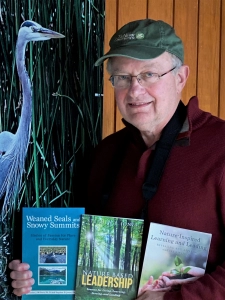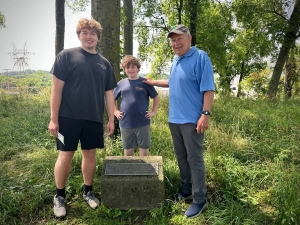Native American Influence on Today’s North Alabama Forests
Preparing for my July 15, 2025, presentation to the Madison Historical Association on the pre-European settlement forests of our Huntsville, Alabama region, I visited two regional Native American historical sites on June 10, 2025: Florence Indian Mound and Museum; Oakville Indian Mounds and Education Center. My working title for July 15 — Thirteen Millennia of Speculation on the Forests of North Alabama (Later revised to fit on the Library’s announcement: North Alabama’s Forests in 1775!). I wanted to supplement my literature research with what I could learn from the Florence and Oakville museums and collections, and perhaps soak up some knowledge and wisdom from physical contact with the mounds and sensing the spirit echoes of ancient occupants.
Florence Indian Mound and Museum
We (wife Judy and our Alabama grandsons Jack (17) and Sam (11)) thought we had made a wrong turn as we drove through a concentrated light industrial area just north of the Tennessee River (Lake Wilson). I anticipated that the mound and museum would be in a less developed setting. Not so, as the parking lot, museum, and adjacent wooded mound suddenly appeared among the buildings, empty lots, and railroad sidings.
Judy and Jack descend 70 stairs (43′) from the mound summit to the handsome museum, framed to eliminate its incongruous surroundings.
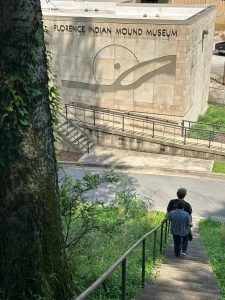
Displays chronicle thousands of years when Natives occupied, ultimately domesticated (to varying levels), and civilized north-Alabama and all of America. This placard reads, “In Early Woodland time, 2,800-2000 years ago, small family groups in this area lived in semi-permanent base camps along the Tennessee River. The Valley provided most of their hunting and fishing needs, so there was little call for distant travel…”
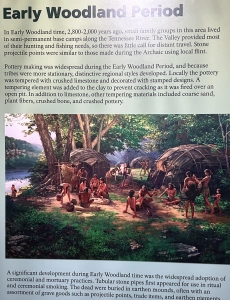
The text continues, “A significant development during Early Woodland time was the widespread adoption of ceremonial and mortuary practices.” The 43-foot high Florence Ceremonial Mound is one such example. Oh, the mysteries that lie buried by time — literally and figuratively! If only we could shake away the obscuring blanket of the past 200 years of European agricultural and industrial disturbance. How large, elaborate, and extensive was the village/community surrounding this magnificent mound?
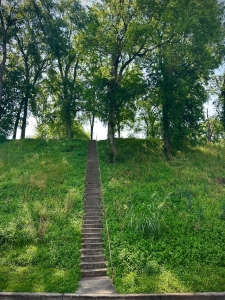
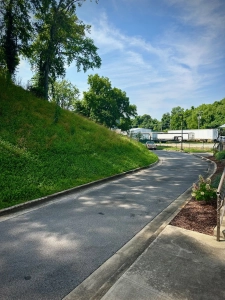
The literature I’ve perused summarizes:
- Nearly all eastern Natives lived in villages
- Surrounded by fields
- Growing a rich variety of crops
- Sturdy, defensible, and weatherproof wooden structures
- Forestland beyond
I am grateful that the City of Florence salvaged a fragment, albeit merely a provocative glimpse, of the past that shaped and defined the Valley culture for many centuries.
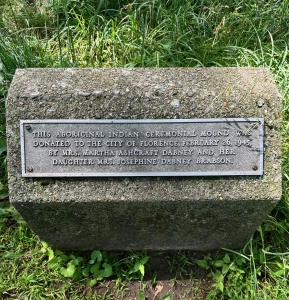
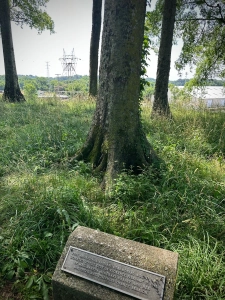
I felt an abslute sadness for what modern-day human development has erased. Power lines, railroad spurs, warehouses, and other advancements dampen the educational contributions of the well-executed museum.
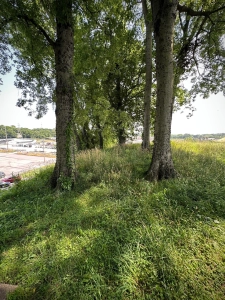
I often observe that I am an enthusiast of special places and everyday Nature, elements woefully lacking at Florence Mound and Museum. Regardless, I compliment those who reserved the mound and created the museum and collections to preserve the memory of the grandeur of Native culture and civilization. I can almost imagine the ancient landscape as the mound emerged from the Early Woodland landscape along the mighty river.
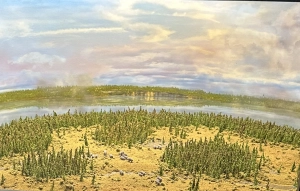
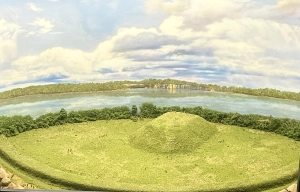
The plaque reads, “During Late Woodland time, 1,500-1,000 years ago, expanding population led to more competition for resources and increased fighting between camps. Settlements were more self-sufficient with increased dependence on cultivated crops, like corn, squash, and beans.”
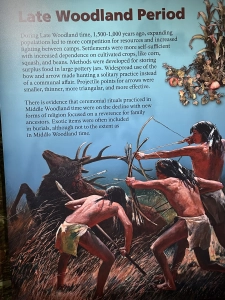
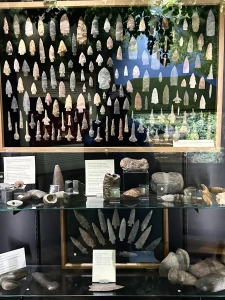
We departed Florence for the Oakville Mounds and Education Center, hoping to see something less disturbed by a vibrant modern-day city along a commercial impounded river.
Oakville Indian Mounds and Education Center
“Rising 27 feet high, this is the largest woodland mound in Alabama, with a base covering 1.8 acres and a flat top of over an acre. Built by Copena Indians, the mound is 2,000 years old… and was used for ceremonial, religious, social, and cultural purposes.”
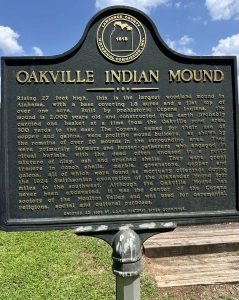
So nice to stand atop the primary mound and see less-altered place, meadows, and tree edges. However, center docents reminded us that two centuries of intensive agriculture have obliterated less significant mounds, ramps, dikes, ditches, and other village/community remnants. The view from the 27-foot mound surpasses the light industrial blemish dominating the viewscape at Florence Mound. Yet I yearned to see what existed a millennium prior.
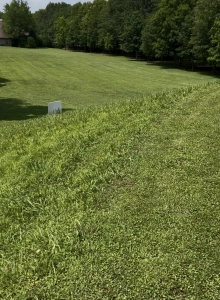
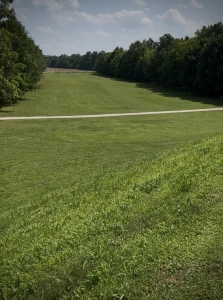
I recorded this 59-second video from atop the ceremonial mound.
I accepted the peek into a shaded grove below the mound’s northwest edge.
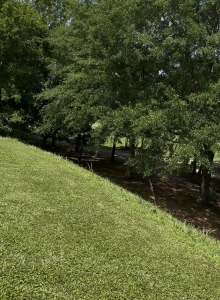
The site also preserves an associated remaing burial mound.
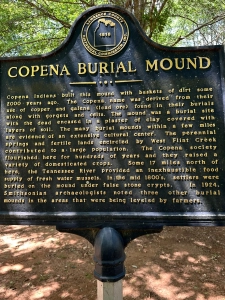
How many were interred here? Over what period of time? Who was the first? The last? Who knows their story?
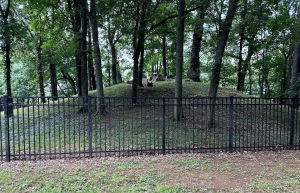
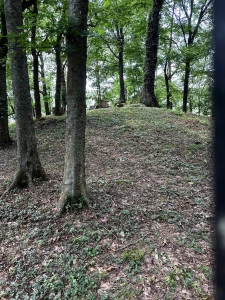
Who could ask for a more fittingly tranquil final resting place, softly mounded under a forest canopy?
Laborers constructed the ceremonial and burial mounds from sand, silt, and clay excavated one basket at a time from what is now Oakville Lake. Located on the Oakville Mounds and Education Center property, the lake is open to fishing and pedestrian trails circuit it. Across how many generations did the lake mirror life at the village?
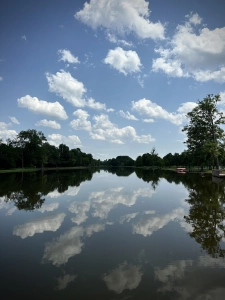
I recorded this 59-second video of the pond.
The museum collections are expansive and warrant time spent in appreciation and study.
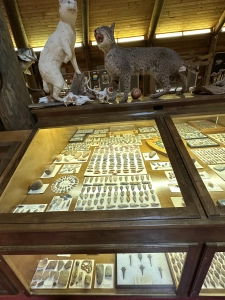

I found an online illustration: “Native American Culture of the Southeast,” which shaped my image of what the Oakville and Florence communities may have resembled 500-2,000 years ago.
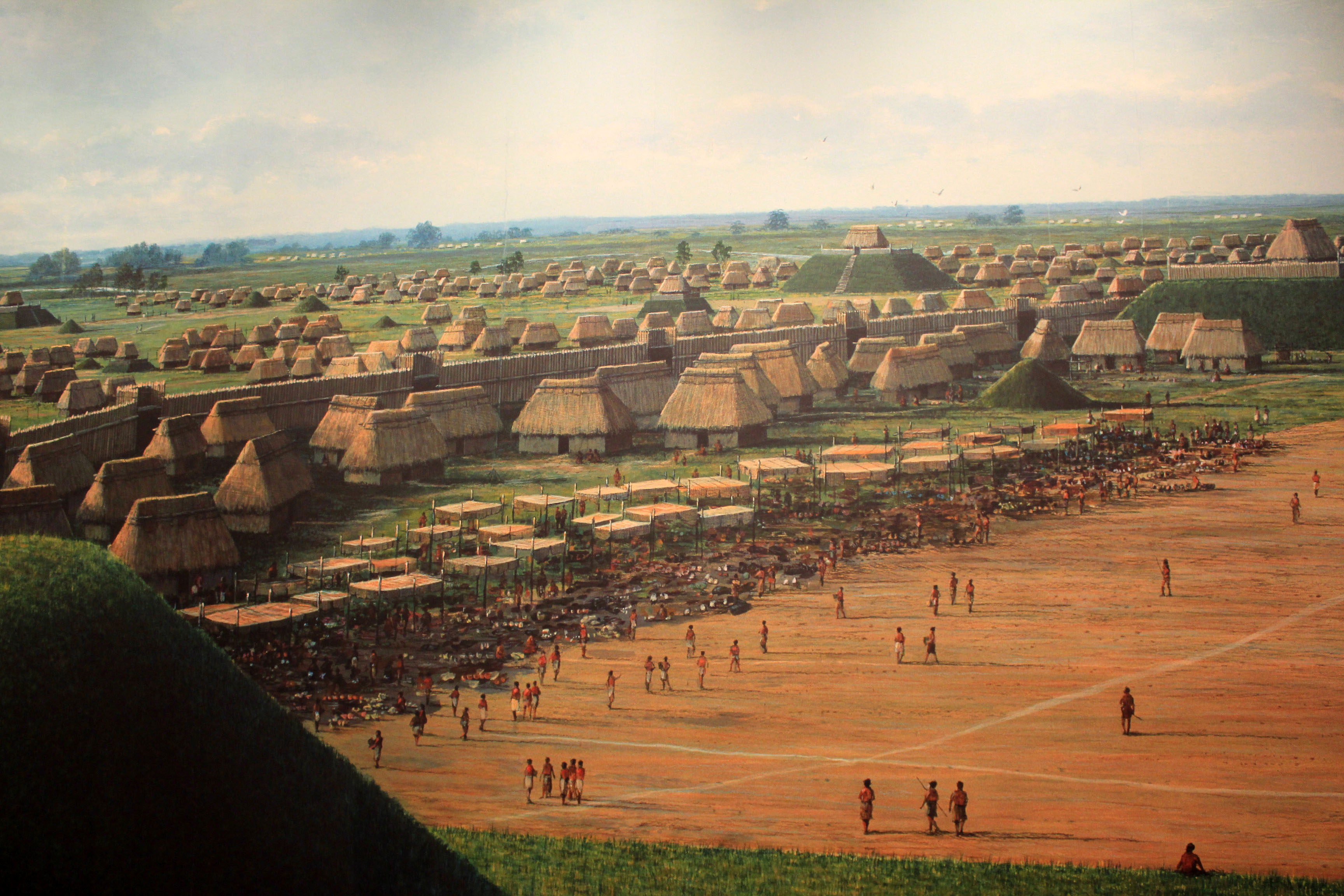
The image depicts all but the surrounding forests that I will discuss in my July 15 presentation.
I repeat for emphasis the five defining characteristics of our Native American predecessors:
- Nearly all eastern Natives lived in villages
- Surrounded by fields
- Growing a rich variety of crops
- Sturdy, defensible, and weatherproof wooden structures
- Forestland beyond
North Alabama Forests and Landscapes Today
The Wheeler National Wildlife Refuge occupies 35,000 acres adjacent to Wheeler Lake, just one impoundment on the Tennessee River upstream from Florence’s Lake Wilson. The refuge is a varied landscape of open fields (planted for winter waterfowl food), forests, marshes, swamps, streams, and open water.
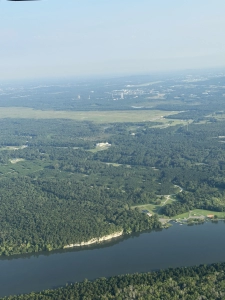
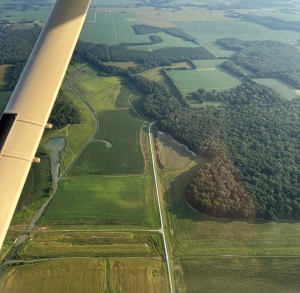
How different did these lands appear 500 to 2,000 years ago?
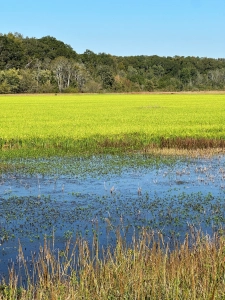
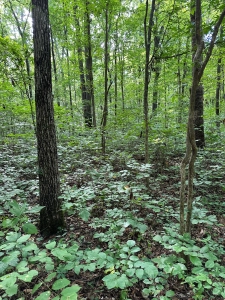
Prior to Wilson Dam construction the dynamic Tennessee River influenced what is now the refuge. Seasonal flooding, periodic course shifting, inflow stream (e.g., Flint River, Paint Rock River, Limestone Creek, Elk River, and others) fluxes, nomadic beaver ponding, and debris damming and release, among other natural forces changed the complexion of those perennially fertile lands. Native agriculture, communities and land uses likewise shifted with the natural changes. Native land use and the corresponding impact to the land varied across the centuries and millennia.
I’ve written often about the epic changes in the land since Wheeler Dam closed its gates 90 years ago. The lake innundates fields, forests, and communities — both modern day and Native. Acres of adjoining uplands acquired as buffer included tilled and grazed agriculture since regenerated naturally to forest. Nothing in Nature is static, whether influenced by 13,000 years of Native occupation or more than two centuries of European domestication.
Huntsville’s Goldsmith-Schiffman Wildlife Sanctuary lies along the Flint River, a tributary that empties into Wheeler a handful of miles upstream from the refuge. I met in May with local archaeologist Ben Hoksbergen, who conducted an archeology survey on the 400-acre sanctuary. He identified four Native sites. He will visit one or more of the sites with me in the fall. I mention the refuge and the sanctuary only to emphasize that Natives occupied our region for at least 13,000 years. Their impact is not insignificant, nor is ours.
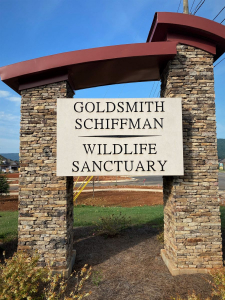
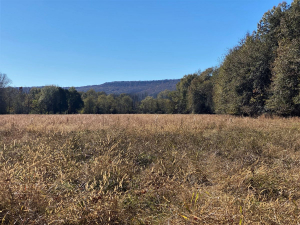
They used the land for all manner of life, living, sustenance, habitat, shelter, community, religious pratice, commerce, trade, and even warring. A casual look doesn’t signal their prior occupation, but I can assure you that the field below holds artifacts (points, shards, chips, pottery fragments, and other evidence of Native life) in its surface soil, in addition to Ben’s four discreet sites.
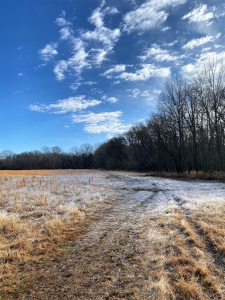

Our pre-European forests were certainly wild. Can we describe them as wilderness? Not by the 1964 US Wilderness Act: A wilderness, in contrast with those areas where man and his own works dominate the landscape, is hereby recognized as an area where the earth and its community of life are untrammeled by man, where man himself is a visitor who does not remain. Our north Alabama forests, instead, were trammeled by man for at least 13,000 years! Native Americans began their North American occupation as nomadic hunter/gatherer units, eventually progressing to semi-permanent agricultural communities. They lived on and from the land:
- fished the waters
- gathered shellfish
- foraged herbs, nuts, fruits
- hunted game
- harvested forest products
- cleared forests
- tilled the land
- grew crops (beans, maize, squash…)
- burned fields and forests
- maintained forest and stream routes for travel and commerce
What affect did hunting wooly mammoths, mastodons, and saber-tooth tigers to extinction have on forest and range ecosystems? The same question stands for extirpating eastern elk and bison. Natives used fire extensively to maintain forage crops and game habitat. To enhance visibility around villages to protect from marauders and invaders. Humans impact our environment, measurably and continuously. Native impact was extensive across the ages, yet those 13 millennia in aggregate changed the land. Our impact over the past 200 years is intensive. Aldo Leopold, who is judged by some (me among them) as America’s greatest conservation practioner and philosopher, lamented conservation of wildness thusly:
All conservation of wildness is self-defeating, for to cherish we must see and fondle, and when enough have seen and fondled, there is no wilderness left to cherish.
A Sand County Almanac (Aldo Leopold 1949)
We humans have seen, fondled, and extracted much from our precious Tennessee River Valley for the 13 millennia we have resided here. We can and must practice informed and responsible Earth stewardship. The Wheeler Refuge and the Goldsmith-Schiffman Sanctuary are evidence that we recognize our imperative to do just that. The Natives had a lighter touch; their numbers required less. The Land is forgiving; Nature is resilient.
Conclusion
I said at the outset of this photo essay:
I hoped to supplement my literature research with what I could learn from the Florence and Oakville museums and collections, and perhaps I could soak some knowledge and wisdom from physical contact with the mounds and sensing the spirit echoes of ancient occupants.
Did I accomplish my objective? I think so. Can I now describe definitively the Native-shaped landscape that greeted the first European settlers reaching our Tennessee Valley? No, but I can state with greater confidence that the Valley bears the influence of millennia of Native life and living, and that change and human influence remain a constant. But for the accelerating rate of human trammeling, flora (trees, shrubs, and herbs) and their successional constants continue to operate. The mosaic, again except for scale and pace, remains unaltered. If we could assess blind to the explosive expansion of human infrastructure, we could slip back 100, 500, 1,000 years and beyond without needing to learn a new ecology (the branch of biology that deals with the relationships of organisms to one another and to their physical surroundings).
An old axiom applies to my dive into the complex and ongoing interplay of humans, Nature, and landscape here in our Tennessee Valley:
The more things change the more they stay the same.
The first recorded use of this expression is by French critic, journalist, and novelist Alphonse Karr in 1849 in Les Guêpes, a monthly journal he founded.
Thoughts and Reflections
I offer these observations:
- Nature is a mosaic of place, time, and use; every landscape reflects the past and portends the future. (Steve Jones)
- Understanding Nature demands looking back and gazing ahead. (Steve Jones)
- All conservation of wildness is self-defeating, for to cherish we must see and fondle, and when enough have seen and fondled, there is no wilderness left to cherish. (Aldo Leopold)
- The more things change the more they stay the same. (Alphonse Karr)
Inhale and absorb Nature’s elixir. May Nature Inspire, Inform, and Reward you!
Note: All blog post images created & photographed by Stephen B. Jones unless otherwise noted. Please circulate images with photo credit: “©2025 Steve Jones, Great Blue Heron LLC. All Rights Reserved.”
I am available for Nature-Inspired Speaking, Writing, and Consulting — contact me at steve.jones.0524@gmail.com
Reminder of my Personal and Professional Purpose, Passion, and Cause
If only more of us viewed our precious environment through the filters I employ. If only my mission and vision could be multiplied untold orders of magnitude:
Mission: Employ writing and speaking to educate, inspire, and enable readers and listeners to understand, appreciate, and enjoy Nature… and accept and practice Earth Stewardship.
Vision:
- People of all ages will pay greater attention to and engage more regularly with Nature… and will accept and practice informed and responsible Earth Stewardship.
- They will see their relationship to our natural world with new eyes… and will understand more clearly their Earth home.
Tagline/Motto: Steve (Great Blue Heron) encourages and seeks a better tomorrow through Nature-Inspired Living!
Steve’s Four Books
I wrote my books Nature Based Leadership (2016), Nature-Inspired Learning and Leading (2017), Weaned Seals and Snowy Summits: Stories of Passion for Place and Everyday Nature (2019; co-authored with Dr. Jennifer Wilhoit), and Dutton Land & Cattle: A Land Legacy Story (2023) to encourage all citizens to recognize and appreciate that every lesson for living, learning, serving, and leading is either written indelibly in or is powerfully inspired by Nature. All four of my books present compilations of personal experiences expressing my deep passion for Nature. All four books offer observations and reflections on my relationship with the natural world… and the broader implications for society. Order any from your local indie bookstore, or find them on IndieBound or other online sources such as Amazon and LifeRich.
I began writing books and Posts for several reasons:
- I love hiking and exploring Nature
- I see images I want to (and do) capture with my trusty iPhone camera
- I enjoy explaining those images — an educator at heart
- I don’t play golf!
- I do love writing — it’s the hobby I never needed when my career consumed me
- Judy suggested my writing is in large measure my legacy to our two kids, our five grandkids, and all the unborn generations beyond
- And finally, perhaps my books and Blogs could reach beyond family and touch a few other lives… sow some seeds for the future
